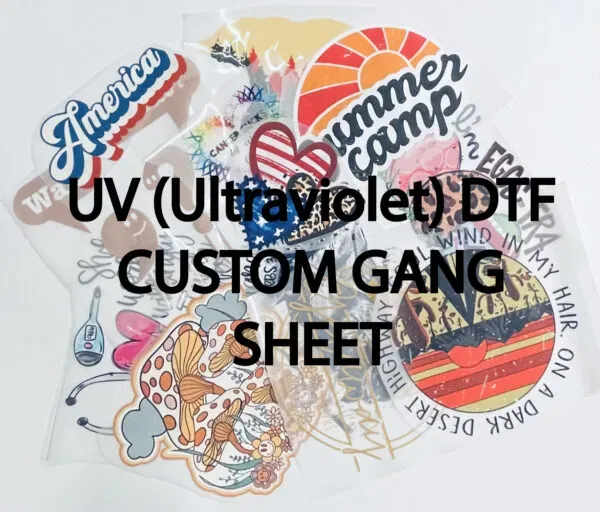In the ever-evolving landscape of the printing industry, UV DTF Gangheet stands out as a revolutionary technique that merges innovative UV printing innovations with the efficiency of Direct-to-Film technology. This breakthrough method offers businesses custom printing solutions that not only enhance vibrancy and detail but also champion sustainable printing practices. As the demand for unique and personalized products skyrockets, the UV DTF market growth showcases its potential to redefine manufacturing and creative design across various sectors. From textiles to promotional items, UV DTF printing is becoming the go-to choice for companies looking to capture consumers’ attention with high-quality and personalized outputs. Join us as we delve deeper into the unique advantages and the transformative trends surrounding UV DTF Gangheet and its pivotal role in the modern printing narrative.
Emerging as a game changer in digital printing, UV Direct-to-Film (DTF) technology is revolutionizing how products are created and designed. This innovative process blends the convenience of direct-to-film techniques with the fast-acting properties of ultraviolet curing, satisfying the growing market’s need for vibrant and durable designs. Businesses are increasingly opting for this cutting-edge approach to meet consumer demands for personalization and customization in their offerings. As awareness of sustainable practices rises, this type of printing not only caters to aesthetic needs but also supports eco-friendly production methods. Ultimately, the burgeoning growth of the UV DTF market reflects a creative surge that is reshaping the printing industry, paving the way for new possibilities in product creation.
The Fundamentals of UV DTF Printing
UV Direct-to-Film (DTF) printing is revolutionizing the way businesses approach the printing process. This innovative method involves using ultraviolet light to cure inks on a specialized film, which can then be transferred onto various surfaces such as textiles, plastics, or metals. The result is not only vibrant and high-quality imagery but also the ability to produce these prints instantly, which is crucial in today’s fast-paced market. Compared to traditional printing methods, UV DTF printing provides enhanced durability and flexibility, accommodating a wide array of application needs.
Moreover, the UV DTF printing process supports a growing trend toward customization in production. With the ability to print intricate designs and details on-demand, businesses can cater to individual customer preferences, fulfilling orders that require unique touches. This customization is facilitated by the ability to utilize a variety of materials and substrates, thereby expanding creative possibilities in products ranging from creative apparel to promotional materials.
Innovative Ink Technologies Driving Change
Recent advancements in ink technology are playing a pivotal role in the growth of the UV DTF market. The new generation of UV inks is designed to offer exceptional color vibrancy and durability, addressing consumer demands for high-quality outputs. Unlike conventional inks, which often require drying time, UV inks are cured immediately upon exposure to ultraviolet light. This feature not only accelerates the production process but also results in reduced waste, making it both a cost-effective and environmentally friendly choice for businesses.
Additionally, manufacturers are increasingly focused on developing eco-friendly inks that align with sustainable printing practices. These innovations reflect the industry’s movement toward greener production methods, minimizing the environmental impact often associated with traditional printing. As a result, businesses that adopt sustainable ink formulations in their UV DTF printing processes can garner a competitive edge, appealing to eco-conscious consumers who prioritize sustainability.
Enhancing Efficiency Through Automation
In today’s competitive landscape, efficiency is paramount, and the introduction of advanced automation in UV DTF printers has transformed operational capabilities. These state-of-the-art machines come equipped with automated loading and unloading systems, significantly reducing manual labor during the printing process. By streamlining workflow, businesses can achieve quicker turnaround times, accommodating larger orders without compromising on the quality of prints. This level of automation not only boosts productivity but also enhances overall profitability.
Furthermore, automation allows for improved consistency in product quality. By minimizing human error throughout the printing process, companies can deliver uniform prints in terms of color accuracy and detail. As the demand for high-quality custom printing solutions continues to rise, the ability to integrate automated systems effectively positions businesses to meet market expectations while streamlining their operations.
The Importance of Customization in Today’s Market
Customization has emerged as a driving force in the UV DTF printing industry, with consumers increasingly seeking personalized products across various sectors. Whether it’s unique apparel, customized accessories, or tailored promotional items, businesses utilizing UV DTF technology can satisfy this demand by offering specialized printing solutions that align with consumer preferences. This trend not only enhances the buyer’s experience but also enables brands to differentiate themselves in a crowded market.
Moreover, the ability to adapt quickly to consumer trends or specific requests allows businesses to be agile in their production approaches. Companies can respond to shifts in market demands by creating on-demand personalized products, thus minimizing excess inventory and waste, which is a significant advantage in today’s sustainability-oriented consumer landscape. As a result, businesses that invest in UV DTF Gangheet technology are well-poised to thrive amidst emerging custom printing challenges.
Sustainable Practices in UV DTF Printing
Sustainability is no longer just a trend; it is a vital component of business strategy in the printing industry. UV DTF printing is leading the charge toward greener practices by offering a method that reduces waste and energy consumption compared to traditional printing methods. The process’s precision allows for exact ink applications, which minimizes excess material that would otherwise end up in landfills. With increasing consumer awareness regarding sustainability, companies leveraging eco-friendly practices can enhance their brand image and appeal to environmentally conscious buyers.
Additionally, many UV DTF printers now come equipped with features that facilitate waste management and recycling during production. These innovations include processes for reclaiming excess inks and implementing effective waste disposal methods. By focusing on sustainable printing practices, businesses can not only reduce their carbon footprint but also contribute to broader environmental goals, showcasing their commitment to preserving the planet.
Market Growth and Future Opportunities
The UV DTF printing market is experiencing substantial growth, fueled by rising demands across numerous industries such as fashion, packaging, and promotional merchandise. With businesses recognizing the advantages of UV DTF technology, there is a significant investment trend towards this innovative printing solution. As companies aim to enhance their product offerings and meet consumer expectations for speed and customization, the potential for market expansion is immense.
Forecasts suggest that the UV DTF Gangheet will continue to gain traction as businesses increasingly acknowledge the technology’s capabilities. As more companies adopt UV DTF printing, the industry can expect further advancements in technology, resulting in even more efficient production methods and higher product quality. This growth trajectory presents numerous opportunities for companies to innovate, collaborate, and lead the way in the future of printing.
Frequently Asked Questions
What is UV DTF Gangheet and how does it enhance printing capabilities?
UV DTF Gangheet represents a cutting-edge approach in the printing sector that combines UV curing with Direct-to-Film technology. This innovation allows printers to produce vibrant and high-quality outputs efficiently, making it suitable for various surfaces including textiles and plastics. The technology ensures immediate curing which maximizes productivity while minimizing ink waste.
How does UV DTF Gangheet contribute to sustainable printing practices?
The use of UV DTF Gangheet is increasingly recognized for its sustainable printing practices. This method significantly reduces waste and energy consumption compared to traditional printing methods. Moreover, advancements in eco-friendly UV inks align with the demand for environmentally responsible production, supporting manufacturers in minimizing their ecological footprint.
What are the market growth trends related to UV DTF Gangheet?
The UV DTF market is projected to experience substantial growth, driven by rising demands across sectors such as fashion, packaging, and advertising. Businesses are investing in UV DTF technology to stay competitive, which is leading to increased adoption of this innovative printing solution. Reports indicate that this trend will continue as more companies recognize the benefits of UV DTF Gangheet.
Can businesses offer personalized products using UV DTF Gangheet?
Yes, one of the standout features of UV DTF Gangheet is its ability to produce highly customized and personalized products on demand. This flexibility has become a significant advantage for companies, particularly in the fashion industry, allowing them to meet consumer demands for unique items quickly and effectively.
What advancements in ink technology support UV DTF Gangheet?
Recent advancements in ink technology have significantly enhanced UV DTF Gangheet, with the development of high-quality UV inks that offer exceptional color vibrancy and durability. These inks cure instantly when exposed to UV light, allowing for faster turnaround times and less waste, making them ideal for efficient production processes.
How does automation improve the UV DTF printing process?
Automation plays a crucial role in enhancing the UV DTF printing process by reducing manual input and optimizing workflow. Modern UV DTF printers come with automated loading and unloading features, which streamline production, decrease turnaround times, and enable companies to handle larger orders without sacrificing quality.
| Key Point | Description |
|---|---|
| UV DTF Printing Overview | Utilizes UV light to cure inks on films, enabling high-quality, vibrant prints across various surfaces. |
| Advancements in Ink Technology | New UV inks provide enhanced color vibrancy and durability with a focus on eco-friendliness. |
| Increased Efficiency and Automation | Advanced automation features in printers optimize workflow and minimize manual input for faster turnaround. |
| Customization and Personalization | Highly customizable options are now available, catering to the demand for unique, on-demand prints. |
| Sustainability Initiatives | UV DTF printing is a more sustainable alternative, reducing waste and energy consumption significantly. |
| Market Growth | The UV DTF printing market is set to expand with increasing demand across fashion, packaging, and advertisement sectors. |
| Integration with Digital Workflows | Seamless integration with digital systems enhances job management and operational efficiency. |
Summary
UV DTF Gangheet showcases a transformative evolution in the printing industry, marked by significant innovations. As manufacturers adapt to the rising demands for efficiency, customization, and sustainability, UV DTF printing emerges as a frontrunner in modern printing solutions. With cutting-edge advancements in ink technology and enhanced automation processes, businesses can offer a diverse range of vibrant prints while aligning with eco-friendly practices. This technology not only meets but exceeds contemporary market expectations—thus positioning UV DTF Gangheet as the driving force behind the future of printing.



